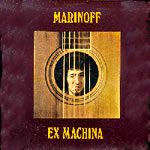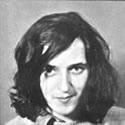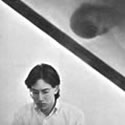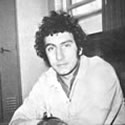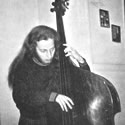|
Side One:
|
Side Two:
|
| Long Way to Go | My Father’s Son |
| On the Beach | Song For Bad Times |
|
Here I Stand Again
|
Ballad of Babe
|
| Up/Down | Yellowbird |
| Devin’s Song | Rag-Time Again |
All songs by Lou Marinoff, except “Up/Down,” by Christopher Baedeker & Lou Marinoff
Recorded and produced at Studio Six, Montreal, Quebec, 1973
Digitally remastered by Phil Bulla / Platinum Productions, Monroe NY, 2014
Published by Gentian Music, © 1973; The selections are BMI.
Acoustic guitar & vocals: Lou Marinoff
Piano & Organ: Steve Corber
Electric Guitar: Steve Armour
Drums, Harmonica & Left Defense: Sonny Stone
Electric & Double Bass: Abbey Sholzberg
Cello (“Devin’s Song”): Iona Corber
Executive Producer: B.B.Covo
Producer: Lou Marinoff
Assistant Producer: Shel Lessingham
Arrangements: Everybody
Engineer: Chuck Grey
Jacket: Bernard de los Cobos
Cover Photo: Peter Hadju
Ex Machina, The Back Story (1973)
During the late 1960s and early 1970s, Montreal was home to a thriving music scene, both visible and also underground. Above board, artists of all genres loved playing Montreal — from folk acts at the Yellow Door coffeehouse, to rock concerts at the Forum, to classical recitals at Place des Arts. Two of the hippest clubs were Gary Eisenkraft’s New Penelope, and Norm Silver’s Esquire Show Bar. These ultra-cool venues featured top blues artists and blues bands of the day, from acoustic Delta styles to the electric South Side sound.
Savvy Montreal audiences soaked up this musical extravaganza. Among them were talented homegrown players, immersed in the era and inspired to original compositions. Living Timothy Leary’s mantra (“Tune in, turn on, drop out”), they jammed in basements, gigged in clubs, and aspired to cut their own record albums.
An epicenter of the underground Montreal music scene was the suburb of Cote St. Luc (pronounced “Coat Saint Luke”). Predominantly Jewish in those days, this outwardly bourgeois but clandestinely psychedelic suburb attracted any number of ironic and often sardonic nicknames: from the “Gilded Ghetto” to the “The Promised Land” to “Cote St. Juif.” By any name, “The Luke” produced an unlikely assortment of world-class talents, from Star Trek icon William Shatner to Harvard psychologist Stephen Pinker.
The core group of musicians on Marinoff Ex Machina also hailed from Cote St. Luc: Steve Armour, Steven Corber, Sonny Stone, and of course Lou himself. Bassist Abbey Sholzberg was parachuted in from nearby Outremont. The band was hand-picked for this album, and it was the first project on which they all played together. They rehearsed for only a few weeks before recording it, and they laid down all ten tracks in one single evening — several of them on the first take. On the second night, they did some overdubs and then the final mix. Their average age was just nineteen, and this was their very first time in a recording studio. They had lived for this moment since early adolescence, and they certainly made the most of it!
Ex Machina was recorded at Studio Six, in downtown Montreal, on St. Antoine Street. Studio Six manager Judy Grey and her partner, chief engineer Chuck Grey, were enchanted with Ex Machina, not only for its originality by also by the enthusiasm and professionalism with which the band laid it down. This was the era of big-budget singles, when major recording labels spent $50,000 – $100,000 on a 2-song 45 rpm. Inflated budgets, incapacitated artists, and unnecessary overproduction padded studio profits, but could be hell to record. Ex Machina was done on a shoestring budget, in two evenings, and sounded like a breath of fresh air to Judy and Chuck — who also thought this band would hit the big-time.
The funniest moment of the sessions undoubtedly belonged to drummer Sonny Stone, the veritable Harpo Marx of this eclectic crew. Prior to laying down the last track, Rag-Time Again, Sonny moved aside the studio’s fabulous array of Zildjian symbols, and replaced them with his own low-end collection of glorified garbage can lids. “What the heck are you doing?” Chuck asked him from the console. “We want that back-alley sound for this number,” said Sonny. Chuck really dug it.
Studio Six was located not too far from Jack’s Pawn shop, where (in those days) Lou’s guitars were constantly in-and-out of hock. Lou is playing his Martin D-18 on Ex Machina, a real gem of a guitar that later vanished into pawn one time too many, and never came back.
This album would have been impossible without the vision of executive producer B.B. Covo, thanks to whom it has enthralled listeners ever since that windy October week of 1973, when Ex Machina’s band blew threw Studio Six like a gust of wind on a mission.
Album Notes
To someone who hasn’t heard it, this album is as colors to a blind man. The style of the music on this record cannot be classified in the popular sense, although its influences are discernible in the songs themselves and in the background of the musicians, all of whom have been classically trained while experiencing, both individually and collectively, the modern idioms of rock, country, blues, jazz and folk. Extremes meet. The continuum reasserts itself. And the result is a technical excellence coupled with a spontaneous range of expression that never lapses into inconsequential virtuosity, but rather acquires a style and vitality all its own..
The lyrics which accompany Lou’s songs neither contradict the rich fabric of the music itself, nor are they superfluous to it. They constitute an explicit voice in the overall dialogue of instruments. In their own dimension they are the faultless rhythms of the experienced poet …
But you must hear and feel for yourself . There is no overproduction here; nothing had to be fixed in the mix. The sound is incredibly alive . . . Add turntable and stir.
— B.B. Covo, Executive Producer
2014: Where Are They Now?
Steve Armour, a brilliant guitarist who later studied classical piano, unfortunately took his own life, but is fondly remembered and sorely missed by all who knew him.
Steven Corber is a Certified Teacher of Transcendental Meditation and a free-lance musician and pianist, with numerous professional successes to his credit.
Lou Marinoff is a Professor of Philosophy at The City College of New York, and an internationally best-selling author, whose guitars are out of pawn (for now).
Abbey Sholzberg continues his career as an in-demand bassist and double-bassist, with multiple performances, credits, and recognition in the Canadian Jazz Archive.
Sonny Stone is a multi-talented musician (drums, sax, clarinet, harmonica) who became creative director for The Mitchell Shore Creative Services and Advertising firm.




